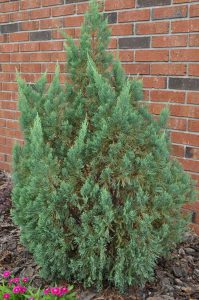The Blue Point Juniper has dense, blue‐green foliage making it a nice specimen tree for landscapes. Its pyramidal form and blue coloring will make a statement and contrast nicely with surrounding plants. Just be sure to give this tree a little room as it prefers not to be crowded at the base. Reaching up to 12 feet tall and 8 feet wide at maturity, this evergreen can also serve as living fence or windbreak when planted at 8-foot centers. As an added bonus, the trees may provide shelter for birds in winter.
 Growing best in cold hardiness zones 4 to 9, Blue Point Junipers are considered low maintenance. Water regularly during establishment, but avoid wetting the foliage. Junipers require well‐drained soils and look best in full sun, although light shade can be beneficial in hot, dry sites. Heavily shaded trees tend to have sparse foliage. Apply a balanced, slow‐release fertilizer 4 to 6 weeks after planting. Established trees generally do not need to be fertilized to maintain plant health. Water needs are also low after establishment. Like most plants, a 2‐ to 3‐inch layer of organic mulch is beneficial to retain soil moisture. Watch for spider mites and bagworms. Diseases of juniper include root rot (a common problem with poor drainage), twig blight, and cedar‐apple rust.
Growing best in cold hardiness zones 4 to 9, Blue Point Junipers are considered low maintenance. Water regularly during establishment, but avoid wetting the foliage. Junipers require well‐drained soils and look best in full sun, although light shade can be beneficial in hot, dry sites. Heavily shaded trees tend to have sparse foliage. Apply a balanced, slow‐release fertilizer 4 to 6 weeks after planting. Established trees generally do not need to be fertilized to maintain plant health. Water needs are also low after establishment. Like most plants, a 2‐ to 3‐inch layer of organic mulch is beneficial to retain soil moisture. Watch for spider mites and bagworms. Diseases of juniper include root rot (a common problem with poor drainage), twig blight, and cedar‐apple rust.
Reference: Ingram, D. and Barrick, W. (1990). Junipers in Florida. ENH34. University of Florida.
Photo credits: Alicia Lamborn
Click here for additional resources on Junipers.
 0
0
